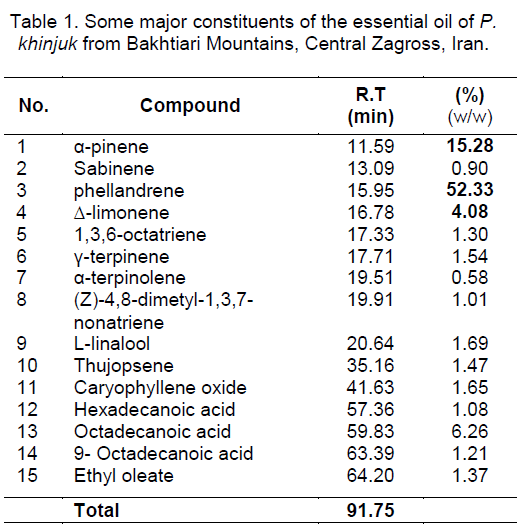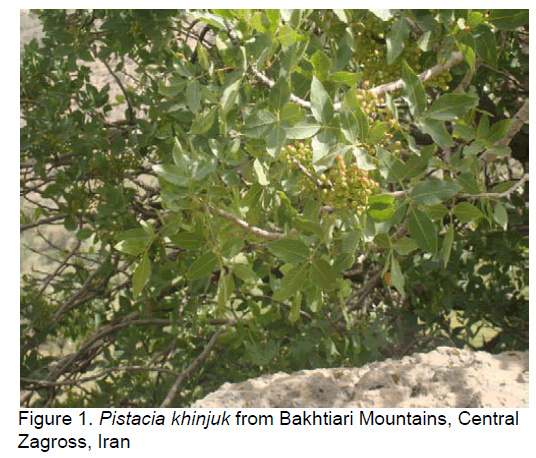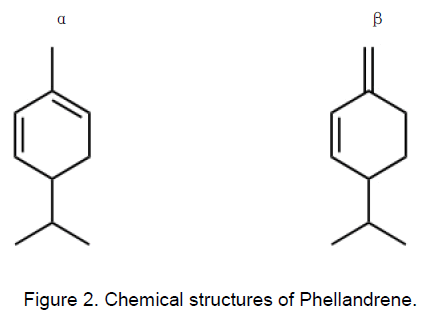Chemical Composition of Essential Oil of Pistacia khinjuk Stocks Grown in Bakhtiari Zagross Mountains, Iran
A. Ghasemi Pirbalouti, K. Aghaee
Shahrekord Branch, Islamic Azad University, Department of Medicinal Plants, Researches Centre of Medicinal Plants & Ethno-veterinary, Shahrekord, POBox: 166, Iran.
Abstract
Pistacia khinjuk Stocks is an evergreen shrub or tree of the family Anarcadiaceae. This species is native to Iran. The resin of P. khinjuk has been used to treat indigestion, and toothache and as a tonic and astringent in Bakhtiari folk medicine. In addition, fruits of P. khinjuk are used as edible wild fruits. The plant is known as Khenjuk or Kelkhong in Persian. Because of a lack of information in the literature about the composition of the volatile fraction of the fruits of P. khinjuk, the current study was undertaken to examine the chemical constituents of the essential oil of the fresh fruits of P. khinjuk growing in Bakhtiari Zagross Mountains, Iran. Fruits of P. khinjuk collected throughout Chaharmahal va Bakhtiari province, Southwest Iran, were examined for chemical variability in fruits for components. Fresh fruits of plants of P. khinjuk were hydro-distilled on a Clevenger type apparatus for 3 h, and studied by gas chromatography (GC) and gas chromatography-mass spectrometry (GC-MS). The chemical constituents identified by GC and GC/MS, the results concerning the qualitative and quantitative analysis of the essential oil are presented. A total of, 95 compounds were identified in the essential oil of P. khinjuk. The main constituents were found to be Phellandrene (52.33%) (w/w) and α-pinene (15.27%) (w/w).
Keywords
Pistacia khinjuk Stocks, essential oil, fruits, phellandrene
1. Introduction
The genus Pistacia (family Anacardiaceae), is widely distributed in the Mediterranean and Middle East areas [1]. Among the 15 known species of pistachios, only 3 species grow in Iran, including Pistacia vera, Pistacia khinjuk and Pistacia atlantica [2]. These are shrubs and small trees growing to 5-15 ml tall. The leaves are alternate, pinnately compounds and can be either evergreen or deciduous depending on species. They are the most important species of pistachio in Iran is known as the origin of pistachios. P. khinjuk is spread in places where the attitude is 700 - 2000 meter above sea level [3]. P. khinjuk is a native plant in Iran, which resin this plant has been used as an indigestion, tonic, toothache and astringent in Bakhtiari folk medicine. In addition, fruits of P. khinjuk used edible wild fruits. The plant is known as Khenjuk or Kelkhong in Persian [4].
Essential oil of leaves of P. khinjuk Stocks prepared by hydrodistillation, and studied by GC and GC-MS, showed qualitative and quantitative differences. Essential oil of leaves of P. khinjuk was found to be rich in monoterpene hydrocarbons. In P. khinjuk 16% (w/w) monoterpene alcohols was detected, and no sesquiterpene alcohols [5].
Because no information was available in the literature about the composition of the volatile fraction of the fruits of Pistacia khinjuk, we decided to examine the chemical constituents of the essential oil of the fresh fruits of Pistacia khinjuk growing in Bakhtiari Zagross Mountains, Iran.
2. Methods
The fresh fruits were collected from of wild populations of Pistacia khinjuk from Lordegan, Bakhtiari Zagross Mountains (Latitude 30-31°, longitude 50-51° and altitude 2000-2300 m above sea level), Chaharmahal va Bakhtiari province, Southwest Iran. The samples of the plants were identified by regional floras and voucher specimens were deposited at the Herbarium of Agriculture and Natural Resources Researches Centre of Chaharmahal va Bakhtiari province, Iran (Figure 1.). Fruits were subjected to hydro-distillation (1000 ml distillate water) for 2 h using a Clevenger- type apparatus according to the method recommended in British pharmacopoeia [6]. Samples were dried with anhydrous sodium sulphate and kept in amber vials at 4 °C until chromatographic analysis.
Oil obtained from fruits of Pistacia khinjuk was analysed using a Younglin Acme 6000 gas chromatograph (Young Lin, Dongan-gu, Anyang-si, Kyounggi-do, Korea) with HP-5MS 5% phenylmethylsiloxane capillary column (30 m x 0.25 mm, 0.25 μm film thickness) equipped with an FID detector. Oven temperature was kept at 50 °C for 5 min initially, and then raised at the rate of 3 °C/min to 240 °C. Injector and detector temperatures were set at 290 and 300 °C, respectively. Helium was used as carrier gas at a flow rate of 0.8 ml/min, and diluted samples (1/1000 in n-pentane, v/v) of 1.0 μl were injected manually in the splitless mode. Peak area percents were used for obtaining quantitative data.
Gas chromatography–mass spectrometry (GC/MS) was used for the identification of volatile components in Pistacia khinjuk. The GC/MS analyses were carried out using an Agilent HP-6890 gas chromatograph (Agilent Technologies, Palo Alto, CA, USA) with a HP-5MS 5% phenylmethylsiloxane capillary column (30 m x 0.25 mm, 0.25 μm film thickness; Restek, Bellefonte, PA) equipped with an Agilent HP-5973 mass selective detector in the electron impact mode (Ionization energy: 70 eV) operating under the same conditions as described for GC analysis. Retention indices were calculated for all components using a homologous series of n-alkanes injected in conditions equal to samples ones. Identification of components of essential oil was based on retention indices (RI) relative to n-alkanes and computer matching with the Wiley275.L and Wiley7n.L libraries, as well as comparisons of the fragmentation pattern of the mass spectra with data published in the literature [7].
3. Results and Discussion
The chemical constituents identified by GC and GC/MS, the results concerning the qualitative and quantitative analysis of the essential oil are presented in the Table 1. In the essential oil of P. khinjuk, 95 compounds were identified. The main constituents were found to be phellandrene (52.33%) (w/w) and α-pinene (15.27%) (w/w). Other components (80 compounds) were present in amounts less than 6%.

In a previous study [8], the main components of the green external skin of fruits of P. khinjuk were reported to be 1, 8 – Cineole (11.09%) (w/w), 1, 5 - Heptadien -4- one, 3, 3, 6 trimethyl (35.76%) (w/w), Camphor (26.34%) (w/w) and β-Selinene (10.15%) (w/w). Further studies in related species have identified triterpenes in the galls of P. terebinthus L. [9] and P. Lentiscus [10] and in the bled resin of P. uera L. [11] P.atlantica Desf. subsp. mutica (Fisher et C. A. Meyer) Rech. r. was reported to contain a-pinene, P-pinene, limonene and myrtenol (or pinocarveol) [12].
De Pooter et al., [5] reported that the essential oils of leaves of P. khinjuk Stocks, P. chinensis Bunge and P. lentiscus L, prepared by hydrodistillation, and studied by GC and GC-MS, showed qualitative and quantitative differences. All three were found to be rich in monoterpene hydrocarbons. In P. lentiscus 4 % sesquiterpene alcohols were found, and no monoterpene alcohols, whereas in P. khinjuk and P. chinensis 16% and 8% monoterpene alcohols respectively were detected, and no sesquiterpene alcohols. Some major constituents of essential oil from the aerial parts of P. khinjuk are α-pinene, β-pinene, Myrcene, beta-caryophyllene, Germacrene B and Spathulenol [5].
Results of a recent study [13] showed that some of the major constituents of essential oil from the aerial parts of P. khinjuk (Kermanshah, western part of Iran) are α-pinene, β-pinene, myrcene, beta-caryophyllene, germacrene B and spathulenol.
The results obtained in the analyses of the oil of P. khinjuk fruits showed that the main components in fruits were phellandrene (52.33%) (w/w) and α-pinene (15.27%) (w/w). Phellandrene is the name for a pair of organic compounds that have a similar molecular structure and similar chemical properties. Alpha Phellandrene and beta phellandrene are cyclic monoterpenes and are double-bond isomers (Figure 2). The phellandrenes are used in fragrances because of their pleasing aromas. Phellandrenes is mainly found in the essential oils of many species of Anacardiaceae family. For example, monoterpene hydrocarbons with α-phellandrene (35.15–40.38%), limonene + β-phellandrene (21.47–36.62%), β-myrcene (7.61–24.96%) and α-pinene (1.92–2.58%) were found to be the main components in Peruvian pepper tree (Schinus molle L.) [14]. Also, the main components in essential oil of Argentine species Schinus polygamus leaves and fruits resulted to be α-phellandrene and limonene [15]
4. Conclusions
In the present study, the differences in the quantity or quality of Pistacia khinjuk oil composition of the present and a previous study [8] may be because of the collection time, chemotypes, environmental conditions, mode of distillation and geographic.
Acknowledgements
The authors are thankful to Mr. Rahim Taghizad, Medicinal Plants Institute, Iran for their technical support.
References
- Bailey L.H. (1958) Manual of Cultivated Plants, 4th ed,, Macmillan, New York. pp. 2648.
- Mozaffarian V. (1996). A dictionary of Iranian plant names. Farahang Moaser, Tehran.
- Behboodi B.S. (2003) Ecological distribution study of wild pistachios for selection of rootstock. Options Mediterran, 63: 61-66.
- Ghasemi Pirbalouti A. (2009) Medicinal plants used in Chaharmahal and Bakhtyari districts, Iran. Herba Polon, 55: 69-75.
- De Pooter H.L., Schamp N.M., Aboutabl E.A., et al. (1991) Essential Oils from the Leaves of Three Pistacia Species Grown in Egypt. Flavour Fragrance J., 6: 229-232.
- British Pharmacopoeia (1988) London: Her Majesty's Stationary Office, pp. 137-138.
- Adams R.P. (1995) Identification of essential oil components by gas chromatography/ mass spectroscopy. Carol Stream, IL: Allured Publishing Co.
- Darvish-Tafvizi M.S., Ghasvari-Jahromi M. (2005) Extraction and recognizing of the essential oil of Pistacia khinjuk components. First Seminar of Medicinal & Natural Products Chemistry Shiraz, Iran.
- Caputo R.L., Mangoni P. Monaco, Palumbo G. (1975) Triterpenes of galls of Pistacia terebinthus: galls produced by Pemphigus utricularius. Phytochemistry, 14: 809–8
- Monaco P., Caputo R., Palumbo G., et al. (1973) Triterpene components of galls on the leaves of Pistacia terebinthus, produced by Pemphigus semilunarius. Phytochemistry, 12: 25-34. 11Caputo R.L. Mangoni P. Monaco, Palumbo G., et al. (1978) Triterpenes from the bled resin of Pistacia vera. Phytochemistry, 17: 815-817.
- Demyanov, N. Y. A. and V. I. Nilov (1927). Zapiski Gosudarstvennovo Nikitskovo Opitnovo Botanicheskovo Sada, 9, 49 (1926-1927): Chem. Abstr., 21: 3421.
- Taran M., Sharifi M., Azizi E. et al. (2010) Antimicrobial activity of the leaves of Pistacia khinjuk. Iranian J Med. Plants, 9: 81-85.
- Hosnia K., Jemlia M., Dziria S., et al. (2011) Changes in phytochemical, antimicrobial and free radical scavenging activities of the Peruvian pepper tree (Schinus molle L.) as influenced by fruit maturation. Ind Crop Prod., in Press.
- Erazoa S., Delportea C., Negretea R., et al. (2006) Constituents and biological activities of Schinus polygamus. J Ethnopharmacol., 107: 395-400.

Open Access Journals
- Aquaculture & Veterinary Science
- Chemistry & Chemical Sciences
- Clinical Sciences
- Engineering
- General Science
- Genetics & Molecular Biology
- Health Care & Nursing
- Immunology & Microbiology
- Materials Science
- Mathematics & Physics
- Medical Sciences
- Neurology & Psychiatry
- Oncology & Cancer Science
- Pharmaceutical Sciences


